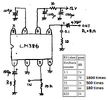The ½w circuit that I built works but it needs improvement. Electret Mic is not sensitive I need to talk 4" from the mic to get a good clear output to ear phones. Which mic will work better? I need ear buds not these ear phones. There are no specs on these ear phones my TV has trouble getting a loud signal our of these ear phones. Power supply is 12vdc 1.8a. I wonder if ear bud package has specs? I am off to Walmart in about 1 hour to look for ear buds. If I can make this circuit work better I will make another circuit board so I have an amp for each ear. Amplification is 200, maybe it needs to me higher or a better Mic? I also have a bass & Treble circuit I can add on for a small amount of tone control. I only have LM386 not the LM386 n-1.





Last edited:




